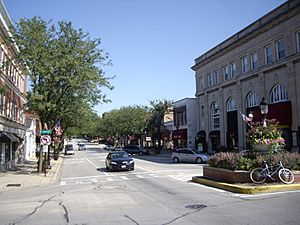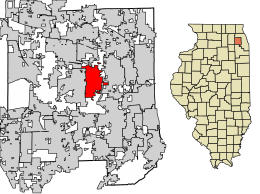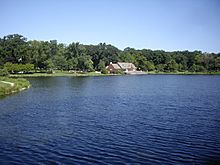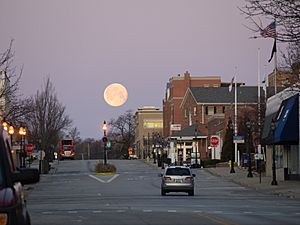Glen Ellyn, Illinois facts for kids
Quick facts for kids
Glen Ellyn
|
||
|---|---|---|
|
Village
|
||
| Village of Glen Ellyn | ||

Glen Ellyn Main Street
|
||
|
||
| Motto(s):
"Village of Volunteers"
|
||

Location of Glen Ellyn in DuPage County, Illinois.
|
||
| Country | ||
| State | Illinois | |
| County | DuPage | |
| Township | Milton | |
| Settled | 1834 | |
| Incorporated | May 10, 1896 | |
| Government | ||
| • Type | Council–manager | |
| Area | ||
| • Total | 7.05 sq mi (18.26 km2) | |
| • Land | 6.89 sq mi (17.84 km2) | |
| • Water | 0.16 sq mi (0.42 km2) 2.36% | |
| Population
(2020)
|
||
| • Total | 28,846 | |
| • Density | 4,187.26/sq mi (1,616.73/km2) | |
| Up 1.7% from 2000 | ||
| Standard of living | ||
| • Per capita income | $39,783 (median: $74,846) | |
| • Home value | $292,930 (median: $278,000 (2000)) | |
| ZIP Codes |
60137, 60820, and 60821
|
|
| Area codes | 630 and 331 | |
| Geocode | 29756 | |
| FIPS code | 17-29756 | |
Glen Ellyn is a village in DuPage County, Illinois, United States. A suburb located 24 miles (39 km) due west of downtown Chicago, the village has a population of 28,846 as of the 2020 Census.
Contents
History
Glen Ellyn, like the neighboring town to the east, Lombard, had its genesis in an 1833 claim by two brothers from the Finger Lakes region of New York, Morgan and Ralph Babcock. The two claimed property in a large stand of timber near present-day St. Charles Road and the East Branch of the DuPage River. The brothers also arranged for a claim for their New York neighbor Deacon Winslow Churchill, who arrived in 1834 along with some of his adult children and their families. The nascent settlement became known as Babcock's Grove, and it included property currently part of both Glen Ellyn and Lombard.
Up the trail from the river to the west was a five-cornered intersection. In 1835, Daniel Fish built a cabin there, and other settlers followed. By the 1840s the intersection was called Fish's Corners and held a general store, blacksmith's forge, shops selling or repairing wagons and harnesses, and a Baptist church.
Moses Stacy, a soldier in the War of 1812, arrived in 1835 and built a house south of Fish's Corners. In 1846, Stacy built at the five corners an inn, Stacy's Tavern, to serve as a halfway stop between Chicago and the Fox River Valley and a probable stop for Galena, Illinois stagecoaches on their way to Rockford, Illinois. Stacy's Tavern, now a historical monument, stands at what is now the intersection of Geneva Road and Main Street.
In 1849, construction of the Galena and Chicago Union Railroad through Glen Ellyn was finished. The railroad was about a mile south of the corners. At first, trains running through the town on the railway did not stop there. A local landowner, Lewey Quitterfield Newton, made an offer to the railroad company: Newton would provide land for a right-of-way and build a depot and water tank if the railroad would require trains to stop there. The depot that Newton built became known as Newton Station, and the locus of the community shifted to the area around the station.
The first church, a Congregational church, was built in 1862. Many Protestant churches were built in the village in the years to come. It was not until 60 years later that the first Catholic church was built.
The growing settlement went through several names, including Babcock's Grove, DuPage Center, Stacy's Corners, Newton's Station, Danby (after Danby, Vermont, a local landowner's birthplace) and Prospect Park. The current Glen Ellyn is based on the Welsh version of the name of village president Thomas E. Hill's wife Ellen, preceded by glen, referring to the local geography.
The name Glen Ellyn had been adopted by 1889, when village president Hill and businessman Philo Stacy spearheaded a project to create a new lake, called Lake Glen Ellyn (today's Lake Ellyn), by having a dam built in a nearby stream.
In 1890, residents discovered mineral springs near the village. This contributed to Glen Ellyn advertising itself as Chicago's newest suburb and health resort, soon followed by the Village of Glen Ellyn being officially incorporated on May 10, 1892. The large Lake Glen Ellyn Hotel opened in 1892, the same year much of the business district was destroyed by fire. Fourteen years later, the hotel was struck by lightning and burned to the ground.
The village's all-volunteer fire department was created in 1907. By the end of the 20th century, it was the last all-volunteer fire department in DuPage County.
By World War I, Glen Oak Country Club served the Oak Park and Glen Ellyn communities, and in 1922 the first Glenbard high school was built.
Geography
The Village of Glen Ellyn is a suburb of Chicago, and it lies about 24 miles (39 km) due west of downtown Chicago.
According to the 2021 census gazetteer files, Glen Ellyn has a total area of 7.01 square miles (18.16 km2), of which 6.85 square miles (17.74 km2) (or 97.70%) is land and 0.16 square miles (0.41 km2) (or 2.30%) is water.
Demographics
| Historical population | |||
|---|---|---|---|
| Census | Pop. | %± | |
| 1890 | 473 | — | |
| 1900 | 793 | 67.7% | |
| 1910 | 1,763 | 122.3% | |
| 1920 | 2,851 | 61.7% | |
| 1930 | 7,680 | 169.4% | |
| 1940 | 8,055 | 4.9% | |
| 1950 | 9,524 | 18.2% | |
| 1960 | 15,972 | 67.7% | |
| 1970 | 21,909 | 37.2% | |
| 1980 | 23,691 | 8.1% | |
| 1990 | 24,944 | 5.3% | |
| 2000 | 26,999 | 8.2% | |
| 2010 | 27,450 | 1.7% | |
| 2020 | 28,846 | 5.1% | |
| U.S. Decennial Census | |||
As of the 2020 census there were 28,846 people, 10,747 households, and 7,529 families residing in the village. The population density was 4,114.39 inhabitants per square mile (1,588.57/km2). There were 11,283 housing units at an average density of 1,609.33 per square mile (621.37/km2). The racial makeup of the village was 78.75% White, 3.32% African American, 0.23% Native American, 8.16% Asian, 0.04% Pacific Islander, 2.77% from other races, and 6.73% from two or more races. Hispanic or Latino of any race were 7.47% of the population.
There were 10,747 households, out of which 34.5% had children under the age of 18 living with them, 61.55% were married couples living together, 6.63% had a female householder with no husband present, and 29.94% were non-families. 26.84% of all households were made up of individuals, and 14.47% had someone living alone who was 65 years of age or older. The average household size was 3.17 and the average family size was 2.58.
The village's age distribution consisted of 26.6% under the age of 18, 6.5% from 18 to 24, 22.3% from 25 to 44, 27% from 45 to 64, and 17.8% who were 65 years of age or older. The median age was 41.0 years. For every 100 females, there were 96.6 males. For every 100 females age 18 and over, there were 97.6 males.
The median income for a household in the village was $118,208, and the median income for a family was $169,358. Males had a median income of $90,561 versus $44,196 for females. The per capita income for the village was $65,328. About 2.2% of families and 4.6% of the population were below the poverty line, including 2.3% of those under age 18 and 1.7% of those age 65 or over.
| Race / Ethnicity (NH = Non-Hispanic) | Pop 2000 | Pop 2010 | Pop 2020 | % 2000 | % 2010 | % 2020 |
|---|---|---|---|---|---|---|
| White alone (NH) | 23,476 | 22,667 | 22,277 | 86.95% | 82.58% | 77.23% |
| Black or African American alone (NH) | 570 | 786 | 947 | 2.11% | 2.86% | 3.28% |
| Native American or Alaska Native alone (NH) | 26 | 20 | 10 | 0.10% | 0.07% | 0.03% |
| Asian alone (NH) | 1,276 | 1,774 | 2,341 | 4.73% | 6.46% | 8.12% |
| Pacific Islander alone (NH) | 2 | 3 | 8 | 0.01% | 0.01% | 0.03% |
| Other race alone (NH) | 27 | 42 | 56 | 0.10% | 0.15% | 0.19% |
| Mixed race or Multiracial (NH) | 347 | 357 | 1,051 | 1.29% | 1.30% | 3.64% |
| Hispanic or Latino (any race) | 1,275 | 1,801 | 2,156 | 4.72% | 6.56% | 7.47% |
| Total | 26,999 | 27,450 | 28,846 | 100.00% | 100.00% | 100.00% |
Economy
According to Glen Ellyn's 2021 Comprehensive Annual Financial Report, the top employers in the city are:
| # | Employer | # of Employees |
|---|---|---|
| 1 | College of DuPage | 3837 |
| 2 | School District 41 | 549 |
| 3 | School District 87 | 485 |
| 4 | Village of Glen Ellyn | 460 |
| 5 | Duly Health and Care | 275 |
Transportation
Glen Ellyn is served by the Metra Union Pacific West Line. The Glen Ellyn station is located at 551 Crescent Blvd, near the heart of the downtown business district. The station is located 22.4 miles (36.0 km) away from Ogilvie Transportation Center, the eastern terminus of the West Line.
Glen Ellyn is served by Pace bus routes 714, 715, and 301 passing through the village on Roosevelt Road.
The Illinois Prairie Path bicycle trail bisects the village and the Great Western Trail (Illinois) passes through the northern edge.
At the east end of the village, Roosevelt Road provides access onto Interstate 355.
Notable people
Glen Ellyn Park District
Glen Ellyn Park District was established on November 3, 1919, as a government agency for the community of Glen Ellyn. The facility was made to provide recreational activities such as, sports, dance, childcare and more. The park district provides more than 700 programs and is open all year round. The park district's year is divided into three seasons: Fall, Winter and Spring/Summer. It has 30 parks that are maintained for the community's use in both recreational and for programmed events like youth football and softball. The district counts with one outdoor aquatic facility Sunset Pool, four recreation buildings, 23 multipurpose parks and playgrounds and two lakes, including Ackerman Sports & Fitness Center and the Lake Ellyn Boathouse. The Park District launches other events like Taste of Glen Ellyn which is a great way to kick off the summer in town and surrounding areas. On Fourth of July the park district puts together a firework show in Lake Ellyn for everyone in the community, also counts with a Fourth of July parade that goes around the streets of the historic downtown Glen Ellyn.
Ackerman Sports Center
The Ackerman Sports Center is located in Glen Ellyn, Illinois it counts with an indoor track, indoor field house, indoor turf soccer field, rock climbing wall, locker rooms and a fitness center. It provides a safe environment for those who are members to the facility, it counts with a variety of activities for children and adults. It also counts with childcare hours for fitness members.
Spring Avenue Recreation Center
The Spring Avenue Recreation Center often referred as "SARC" services as one of the main facilities in the Glen Ellyn Park District. The building counts with a fitness center, fitness studio, dance studios, tumbling/gymnastics facility and a crafts lab. The SARC is also host of the Glen Ellyn Park District's Board of Commissioners meetings. Offering a variety of activities for early childhood, youth and seniors, the Spring Avenue Center is the main hub of the Glen Ellyn Park District, located behind the SARC facility is a fully enclosed dog park.
Main Street Recreation Center
The formerly Main Street School is also one of the main registration facilities in the Glen Ellyn Park District, it counts with surrounding park as a playground, large open play area, athletic fields, one official-sized baseball field, two dance studios, an indoor gymnasium and multi purpose rooms. The MSRC is also home to the offices of Anima - Glen Ellyn Children's Chorus.
Sunset Pool Aquatic Center
Sunset Pool is a summer get away with fun and refreshing activities for early childhood, youth/adults and seniors. It counts with an outdoor, zero depth features as sloping, beach style entry as a well as the sand play area perfect for non-swimming children. It counts with water slides and a concession stand with in the facility. The sunset pool offers a variety of events from BBQ's to back to school bashes and special event rentals.
Education
Higher education
The main campus of College of DuPage is located in Glen Ellyn. Among its alumni are the comedian John Belushi and his actor brother James Belushi.
Public schools
Glen Ellyn's primary schools are part of Glen Ellyn School District 41 and Community Consolidated School District 89. Its high schools are a part of Glenbard Township High School District 87, with the term Glenbard being a blend of Glen Ellyn and Lombard, a village due east of Glen Ellyn.
- High schools
- Glenbard West High School
- Glenbard South High School
- Middle schools
- Glen Crest Middle School
- Hadley Junior High School
- Elementary schools
- Abraham Lincoln Elementary School
- Arbor View Elementary School
- Benjamin Franklin Elementary School
- Churchill Elementary School
- Forest Glen Elementary School
- Park View Elementary School
- Westfield Elementary School
Private schools
- Montessori Academy of Glen Ellyn
- Phillip J. Rock Center and School
- St. James the Apostle Catholic School
- St. Petronille Catholic School
- Maryknoll Montessori School
Sister cities
See also
 In Spanish: Glen Ellyn para niños
In Spanish: Glen Ellyn para niños




